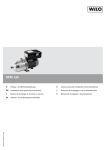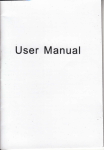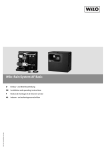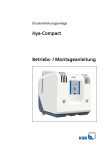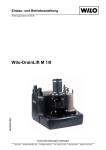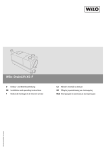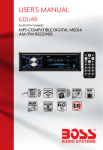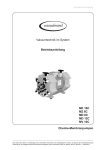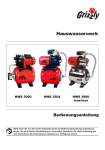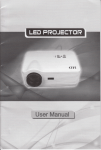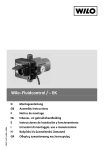Download Wilo-Jet-WJ
Transcript
2050754-Ed.02/2009-09-Wilo Wilo-Jet-WJ D Einbau- und Betriebsanleitung I Istruzioni di montaggio, uso e manutenzione GB Installation and operating instructions CZ Návod k montáži a obsluze F Notice de montage et de mise en service RUS Инструкция по монтажу и эксплуатации NL Inbouw- en bedieningsvoorschriften GR Οδηγίες εγκατάστασης και λειτουργίας E Instrucciones de instalación y funcionamiento TR Montaj ve kullanma kılavuzu Fig. 1 Fig. 2 3 7 9 0,5 M MIN. 2 5 7 12 8 13 11 3 x PH. 6 HC HA MIN. 200mm MIN. 100 mm 4 2 10 1 7 4 7 2 5 ou/or 6 Fig. 3 3~ 230 - 400 V 220 - 280 V / 240 - 415 V 3 X 400 V 3 X 380 V / 3 X 415 V 3 X 230 V 3 X 220 V / 3 X 240 V 3 7 D Einbau- und Betriebsanleitung 4 GB Installation and operating instructions 8 F Notice de montage et de mise en service 12 NL Inbouw- en bedieningsvoorschriften 16 E Instrucciones de instalación y funcionamiento 20 I Istruzioni di montaggio, uso e manutenzione 24 CZ Návod k montáži a obsluze 28 RUS Инструкция по монтажу и эксплуатации 32 GR Οδηγίες εγκατάστασης και λειτουργίας 36 TR Montaj ve kullanma kılavuzu 40 Deutsch 1. Allgemeines Einbau und Inbetriebnahme nur durch Fachpersonal 1.1 Verwendungszweck Mit der Jetpumpe bietet WILO eine preiswerte Wasser-Versorgungsanlage für die Bereiche Haus, Hobby und Garten an. Die Pumpen eignen sich: – Zum Bewässern und Beregnen aus Teichen, Bächen und Brunnen, – Zur Entleerung von Behältern, – Zum Auspumpen überschwemmter Kellerräume. Die Pumpe arbeitet im Saugbetrieb (z.B. aus Brunnen) oder Zulaufbetrieb (z.B. aus offenem Behälter). Die Pumpe darf nicht im direkten Anschluss an das öffentliche Trinkwassernetz angeschlossen werden. 1.2 Angaben über das Erzeugnis 1.2.1 Anschluss- und Leistungsdaten Zulässiges Fördermedium: Wasser ohne Fest-/ Sinkstoffe, Brauch-, Kalt-, Kühl- und Regenwasser. Die Förderung anderer Medien bedarf der Zustimmung der Firma WILO. • • • • • • • • • • Zulässige Temperatur min./max. + 5 °C bis + 35 °C Umgebungstemperatur min./max. 0...40 °C Maximale Saughöhe 8 m 1~: 2850 1/min (50 Hz) 3~: 3450 1/min (60 Hz) Saug- und Druckstutzen DN: RP 1 Max. zulässiger Betriebsdruck 6 bar Isolationsklasse: 130 Schutzart IP 44 Elektrischer Anschluss 1 ~ 230 V ±6%, 50 Hz / 3 ~ 400 V ±6%, 50 Hz / 1 ~ 220-240 V ±6%, 60 Hz 3 ~ 220-254/380-440 V ±6%, 60 Hz Bei Ersatzteilbestellungen sind sämtliche Daten des Anlagentypenschildes anzugeben. 2. Sicherheit Diese Betriebsanleitung enthält grundlegende Hinweise, die bei Aufstellung und Betrieb zu beachten sind. Daher ist diese Betriebsanleitung unbedingt vor Montage und Inbetriebnahme vom Monteur sowie dem zuständigen Betreiber zu lesen. Es sind nicht nur die unter diesem Hauptpunkt Sicherheit aufgeführten allgemeinen Sicherheitshinweise zu beachten, sondern auch die unter den folgenden Hauptpunkten eingefügten, speziellen Sicherheitshinweise. 2.1 Kennzeichnung von Hinweisen in der Betriebsanleitung Allgemeines Gefahrensymbol. Sicherheitshinweise, die bei Nichtbeachtung Gefährdungen Warnung vor elektrischer Spannung ACHTUNG! Sicherheitshinweise, deren Nichtbeachtung Gefahren für die Pumpe/Anlage und deren Funktion hervorrufen können. 4 2.2 Personalqualifikation Das Personal für die Montage muss die entsprechende Qualifikation für diese Arbeiten aufweisen. 2.3 Gefahren bei Nichtbeachtung der Sicherheitshinweise Das Nichtbeachten der Sicherheitshinweise kann eine Gefährdung für Personen und Anlage zur Folge haben. Die Nichtbeachtung der Sicherheitshinweise kann zum Verlust jeglicher Schadenersatzansprüche führen. Im einzelnen kann Nichtbeachten beispielsweise folgende Gefährdungen nach sich ziehen: • Versagen wichtiger Funktionen der Anlage, • Gefährdungen von Personen durch elektrische und mechanische Einwirkungen. 2.4 Sicherheitshinweise für den Betreiber Die bestehenden Vorschriften zur Unfallverhütung sind zu beachten. Dieses Produkt darf nicht durch Personen mit eingeschränkter Zurechnungsfähigkeit (einschließlich Kindern) oder ohne entsprechendes Fachwissen in Betrieb genommen oder bedient werden. Ausnahmen sind nur durch entsprechende Anweisung sicherheitsverantwortlicher Personen zulässig. Gefährdungen durch elektrische Energie sind auszuschließen. Vorschriften des VDE und der örtlichen Energieversorgungsunternehmen beachten. 2.5 Sicherheitshinweise für Inspektions- und Montagearbeiten Der Betreiber hat dafür zu sorgen, dass alle Inspektions- und Montagearbeiten von autorisiertem und qualifiziertem Fachpersonal ausgeführt werden, das sich durch eingehendes Studium der Betriebsanleitung ausreichend informiert hat. Die Arbeiten an der Pumpe/dem Produkt dürfen nur im Stillstand durchgeführt werden. 2.6 Eigenmächtiger Umbau und Ersatzteilherstellung Veränderungen der Anlage sind nur nach Absprache mit dem Hersteller zulässig. Originalersatzteile und vom Hersteller autorisiertes Zubehör dienen der Sicherheit. Die Verwendung anderer Teile kann die Haftung für die daraus entstehenden Folgen aufheben. 2.7 Unzulässige Betriebsweisen Die Betriebssicherheit der gelieferten Anlage ist nur bei bestimmungsmäßiger Verwendung entsprechend Abschnitt 1 der Betriebsanleitung gewährleistet. Die im Datenblatt angegebenen Grenzwerte dürfen auf keinen Fall überschritten werden. 3. Transport und Zwischenlagerung ACHTUNG! Die Pumpe darf keinen Temperaturen außerhalb des Bereiches von 0 °C bis +40 °C ausgesetzt werden. Wird die gelieferte Pumpe erst zu einem späteren Zeitpunkt eingebaut, ist sie gegen Feuchtigkeit, mechanische Beschädigung durch Stoß/Schlag und allen äußeren Einflüssen zu schützen. WILO SE 09/2009 Deutsch Es ist vorsichtig mit der Pumpe umzugehen, so dass die Geometrie und die Ausrichtung der Hydraulik nicht verändert werden. Die Pumpe niemals am Stromkabel aufhängen. 4. Beschreibung von Erzeugnis und Zubehör Alle Typen sind selbstansaugende Kreiselpumpen. Bei den Wechselstrom-Motoren schaltet der thermische Motorschutz den Motor bei Überlastung ab. Nach Abkühlen des Motors schaltet die Pumpe sich automatisch wieder ein. Das Pumpengehäuse ist gegenüber dem Motor mit einer Gleitringdichtung abgedichtet. ACHTUNG!! Die Pumpe darf nicht trocken laufen. Für Schäden an der Pumpe, die durch Trockenlauf entstehen, erlischt die Garantie des Herstellers. 4.1 Beschreibung der Pumpe WJ Die WJ-Typen sind transportable Pumpen. Die EM-Pumpen haben einen Tragegriff und werden anschlussfertig mit Anschlusskabel, Schutzkontaktstecker und Ein-Aus-Schalter geliefert. Maximaler Betriebsdruck – Bild 1: Saugbetrieb – Bild 2: Druckbetrieb am Vorratstank oder am Druckwasser- Anschluss mit TrockenlaufSchutz. Legende für Einbaubeispiele (siehe Bilder 1 und 2): Pos. 1 Ansaug-Fußventil (maximaler Durchgang 1 mm) Pos. 2 Ansaug-Kugelhahn Pos. 3 Auslassventil Pos. 4 Rückflussverhinderer Pos. 5 Füllschraube Pos. 6 Ablassschraube Pos. 7 Rohrbefestigung Pos. 8 Ansaugkorb Pos. 9 Vorratstank Pos. 10 Wasseranschluss Pos. 11 3~ Netzanschluss (DM) Pos. 12 An/Aus-Schalter für 1~-Motor (rote Signalleuchte) Pos. 13 Netzstecker (1~ -Motor) 4.2 Lieferumfang – Jetpumpe (WJ) – Einbau- und Betriebsanleitung. 4.3 Zubehör – Ansaugkit, – Absperrvorrichtung , – Rückflussverhinderer, – Saugkorb-Fußventil, – Membrandruckbehälter, – Schwingungsdämpfer, – Motorschutzrelais, – Trockenlaufschutz (ME-Kit), – Ein-/Aus-Schaltgerät Der Einsatz von neuem Zubehör wird empfohlen. WILO SE 09/2009 5. Aufstellung/Einbau 5.1 Montage Die Pumpe gemäß den Vorschriften des örtlichen Wasser-Versorgungs- Unternehmens betreiben. Anforderungen an den Aufstellungsort: – leicht zugänglich – gut belüftet, trocken und frostsicher – Montage auf einem Beton-Sockel oder direkt auf einem glatten ebenen Untergrund. Folgeschäden, die durch Ausfall der Pumpe entstehen können, wie Überflutung von Räumen, hat der Betreiber durch geeignete Maßnahmen (z. B. Installation einer Alarmanlage, Reservepumpe u.ä.) auszuschließen. – Saug- und Druckleitung sind bauseits beizustellen. – Bei Anschluss von festen Saug- und Druckleitungen ist die Pumpe bauseits am Boden zu befestigen. – Bei nicht fixierter Aufstellung ist die Pumpe zumindest mit flexiblen Schlauch-Übergangsstücken an die Saug- und Druckleitung anzuschließen. – Die Saugleitung steigend, vakuumdicht und spannungsfrei verlegen. – Bei mehr als 5 m Saughöhe sollte der Durchmesser der Saugleitung mindestens 11/4“ betragen. – Druckleitung spannungsfrei an Druckstutzen anschließen. ACHTUNG! Zur Gewährleistung eines einwandfreien Betriebes benötigen die Pumpen eine Wasservorlage von 30 cm, d. h. der Anfang der Druckleitung ist mindestens auf einer Länge von 30 cm steigend zu verlegen. – An die Saugleitung ist ein Fußventil zu montieren. Es sollte mindestens 30 cm unter dem niedrigsten Wasserstand liegen. Grundsätzlich ist die Verwendung eines Saugschlauch- Sets (Zubehör), bestehend aus Saugschlauch, Saugkorb und Fußventil zu empfehlen. 5.2 Elektrischer Anschluss ACHTUNG! Der elektrische Anschluss ist von einem beim örtlichen EVU zugelassenen Elektroinstallateur und entsprechend den geltenden VDE-Vorschriften auszuführen. Die Pumpen sollten nur über einen FehlerstromSchutzschalter von 30 mA angeschlossen werden. – Für den Einsatz in Schwimmbecken und Gartenteichen die Vorschriften nach VDE 0100 Teil 702 einhalten. – Die elektrischen Steckverbindungen überflutungssicher und vor Feuchtigkeit geschützt installieren. – Stromart und Spannung des Netzanschlusses überprüfen. – Typenschilddaten des Pumpenmotors beachten. – Netzseitige Absicherung: 10A, träge. – Erdung beachten. 5 Deutsch Die Pumpen dürfen nur mit einer elektrischen Anschlussleitung (auch Verlängerungsleitung) betrieben werden, die mindestens einer Gummischlauchleitung vom Typ H07 RNF nach DIN 57282 oder DIN 57245 ensprechen. – DM-Motoren nach Bild 3/Anschlussbild im Klemmenkasten verdrahten. – Bei Anschluss einer Drehstrommotor-Pumpe ist ein Motorschutzschalter bauseits vorzusehen. Er ist auf den Nennstrom lt. Typenschild einzustellen. – Erden nicht vergessen. – Ein Anschlussfehler führt zu Motorschaden. – Das Stromkabel darf niemals das Rohr oder die Pumpe berühren; der Schutz vor jeglicher Feuchtigkeit ist sicherzustellen. 6. Inbetriebnahme – Prüfung auf ausreichenden Wasserstand im offenen Vorlaufbehälter bzw. im Brunnen. Trockenlauf der Pumpe unbedingt vermeiden! Er zerstört die Gleitringdichtung. – Pumpe und Saugleitung an der Einfüllschraube befüllen. Nur eine befüllte Pumpe ist selbstansaugend. – Evtl. vorhandene Absperrorgane in der Druckleitung öffnen, damit evtl. Luft in der Saugleitung frei herausgefördert werden kann. – Bei DM-Motoren Drehrichtung kontrollieren: Durch kurzzeitiges Einschalten prüfen, ob die Drehrichtung der Pumpe mit dem Pfeil auf der Lüfterhaube übereinstimmt. Bei falscher Drehrichtung 2 Phasen vertauschen. – Die Pumpe niemals am Netzanschlusskabel anheben, transportieren oder befestigen. – Die Pumpe darf keinem direkten Wasserstrahl ausgesetzt werden. 7. Wartung Vor der Überprüfung Pumpe bzw. Anlage spannungsfrei schalten! Schäden am Anschlusskabel grundsätzlich durch einen qualifizierten Elektroinstallateur beheben lassen. Zur Gewährleistung höchster Betriebssicherheit bei geringstmöglichen Betriebskosten werden folgende, gelegentliche Überprüfungen empfohlen: – Überprüfung des Druckes im Membrandruckbehälter (mindestens 1,4 bar bei Standardeinstellung des Druckschalters), – Pumpe auf Dichtheit prüfen. Bei Frostgefahr muß die Pumpe komplett (einschließlich Behälter) entleert werden. Der Entleerungsstopfen befindet sich an der Pumpenunterseite. Vor längerem Stillstand (z. B. Überwinterung) sollte die Pumpe gründlich durchgespült, komplett entleert und dann trocken gelagert werden. Vor Wiederinbetriebnahme durch kurzes EinAus-Schalten überprüfen, ob die Pumpe frei dreht. Dann wieder mit Wasser auffüllen. 6 WILO SE 09/2009 Deutsch 8. Störungen, Ursachen und Beseitigung Störungen Pumpe läuft nicht an Ursachen Unterbrechung in der Stromzuführung, Kurzschluß, Isolationsfehler in der Motorwicklung Beseitigung Netzspannung überprüfen, Leitung und Motor vom Fachmann überprüfen lassen Pumpe ist durch Fremdkörper blockiert (1) – Anlage spannungsfrei schalten und gegen unbefugtes Wiedereinschalten sichern – Absperrarmatur hinter der Pumpe schließen – Pumpe aus dem Sumpf herausheben – Fremdkörper aus der Pumpe entfernen Motor überhitzt Thermoschutz- Schalter hat ausgelöst Pumpe läuft, aber fördert nicht oder zu wenig Motorschutzschalter hat ausgelöst (1 ~ -Motor) Pumpe/Motor abkühlen lassen Zu geringe Betriebsspannung Spannung an den Anschlussklemmen prüfen. Sie sollte innerhalb von ± 6 % (50 Hz), bzw. ± 6 % (60 Hz) der Nennspannung liegen Pumpe ist durch äußere Einflüsse blockiert (siehe 1) Umgebungstemperatur über +40 °C Der Motor ist auf eine maximale Umgebungstemperatur von +40 °C ausgelegt Aufstellort > 1000 m Der Motor ist für ein Betriebsniveau von ≤ 1000 m ausgelegt Thermo-Schutzschalter falsch eingestellt (3 ~ -Motor) auf Nennstrom einstellen Spannung ist zu niedrig Überprüfen, ob der Kabelquerschnitt ausreichend ist Eine Phase is unterbrochen Phasen überprüfen und falls erforderlich Kabel austauschen Thermo-Schutzschalter defekt austauschen Motor defekt austauschen Pumpe ist durch äußere Einflüsse blockiert Pumpe leergelaufen Luft in der Saugleitung (siehe 1) Saugleitung verstopft Falsche Drehrichtung (3 ~ -Motor) Pumpe vibriert Bodenverschraubung ist locker Pumpe ist durch äußere Einflüsse blockiert Elektrische Verbindung fehlerhaft Pumpe füllen Gesamte Zuleitung bis zur Pumpe auf Dichtheit prüfen und abdichten Saugleitung reinigen 2 Phasen des Netzanschlusses vertauschen Alle Befestigungsbolzen prüfen und festziehen (siehe 1) Elektrische Verbindung überprüfen Eine Verstopfung der Pumpe kann in den meisten Fällen dadurch beseitigt werden, dass zunächst der Saugschlauch abgenommen und die Pumpe dann rückwärts unter Druck durchgespült wird. Während des Durchspülens die Pumpe mehrmals für 2 Sekunden einschalten. Läßt sich die Betriebsstörung nicht beheben, wenden Sie sich bitte an das Fachhandwerk oder an die nächstgelegene WILO-Kundendienststelle oder Vertretung. WILO SE 09/2009 7 English 1. General Installation and service by qualified personnel only 1.1 Application With the Jet-pump WlLO offers an inexpensive water supply unit in the fields of home, hobby and garden. The pumps are suitable for: – watering and sprinkling from ponds, creeks and bores, – draining of tanks and containers, – dewatering of flooded basements. The pump works self-priming (e.g. from bores) or with flooded suction (e.g. from open tanks). It must not be connected directly to public water supply systems. 1.2 Product Information 1.2.1 Technical Data Suitable media: Water without solid particles, domestic, cold, cooling and rain water. Use of other media requires WlLO's consent. • • • • • • • • • • Temperature min./max. + 5 °C to + 35 °C Environment temperature min./max. 0...40 °C Maximum suction lift 8 m Single-phase (EM): 2850 1/min (50 Hz) Three-phase (DM): 3450 1/min (60 Hz) Size suction/discharge ports: 1”BSP Max. working pressure 6 bar Insulation class 130 Protection index IP 44 Electrical connection 1 ~ 230 V ±6%, 50 Hz / 3 ~ 400 V ±6%, 50 Hz / 1 ~ 220-240 V ±6%, 60 Hz 3 ~ 220-254/380-440 V ±6%, 60 Hz When ordering spare parts, please state all name plate data. 2. Safety These instructions contain basic rules on safety which must be strictly adhered to. It is therefore imperative for the Installer and the Operator to carefully read these instructions prior to installation and commissioning. Please observe, not only the safety directions under the main heading Safety Rules, but also those added and specially marked under the ensuing headers. 2.1 Safety marks contained in these Instructions Danger from general causes. Safety references contained which, if not complied with, may cause death or severe physical injury to persons. Danger from electrical causes ATTENTION! Safety references which, if not complied with, may result in damage to the plant or its function. 2.2 Personnel qualification Only suitably qualified personnel may work on this equipment . 2.3 Dangers from non-observance of safety hints Non-observance of safety reference may cause bodily harm to persons or damage to the plant. 8 Failure to comply with safety reference could invalidate warranty and/or damage claims. In detail, non-compliance may, for example, cause the following dangerous possibilities: • Failure of vital plant functions or damage to the pump, • Causing personal injury due to electrical and/or mechanical causes. 2.4 Safety reference for the Operator Local regulations for the prevention of accidents must be observed. This appliance is not intended for use by persons (including children) with reduced physical, sensory or mental capabilities, or lack of experience and knowledge, unless they have been given supervision or instruction concerning use of the appliance by a person responsible for their safety. Danger tram electrical energy must be excluded (conforming to local or general regulations such as lEG, 881, VDE etc.). 2.5 Safety reference for Inspections and Installation work It is the Operator's responsibility to ensure that inspections and installation work are carried out by authorized and qualilied personnel only, having themselves made lully conversant with these instructions. Work must principally be carried out only with the plant switched off and at complete standstill. 2.6 Arbitrary alterations and spare part procurement Any alterations to the plant are only permitted in agreement with the manulacturers. Original spare parts and authorized accessories serve safety and reliability. The use of unauthorized parts could invalidate any claims tor consequential damages. 2.7 Abnormal Operating Conditions Operational salety of the plant is only ensured il used in accordance with Ghapter 1 of these instructions. The limits stated there must not be exceeded under any circumstances. 3. Transport and Storage ATTENTION! The pump must not be subjected to temperatures outside the limits of 0 °C to + 40 °C. If the equipment delivered is to be installed at some later time, store it in a dry place and protect it from impacts and all external influences (moisture, frost, etc.). Handle the pump carrefully so as not to alter the geometry and the alignment of the hydraulic unit. Never suspend the pump from the power cord. 4. Description of Product and Accessories All WJ-series pumps are self-priming.AlI parts in contact with the medium being handled are of corrosion-resistant steel. Single-phase motors have built-in thermal contacts, switching off the motor on overload and on again after a cooling down period. A mechanical seal separates the pump housing from the motor. WILO SE 09/2009 English ATTENTION! The pump must not run dry. Warranty does not cover damages to the pu mp due to dryrunning. 4.1 Description of WJ-Series Pump Series WJ pumps are portable for mobile application. Single phase pumps have a carrying grip and are supplied complete with power cable, plug and ON/OFF switch. Standard-Installations – Figure 1: Pump in suction – Figure 2: Pump under pressure on storage tank or on town water supply with dry-running protection system. Legend for Installation samples (see figures 1 and 2): Pos. 1 Strainer-foot valve (maximum passing section 1 mm) Pos. 2 Pump suction valve Pos. 3 Pump discharge valve Pos. 4 Non-return valve Pos. 5 Filling plug Pos. 6 Draining plug Pos. 7 Pipe supports Pos. 8 Strainer Pos. 9 Storage tank Pos. 10 Town water supply Pos. 11 3~ motor protection relay Pos. 12 OFF/ON switch for single phase motor (red indicator light) Pos. 13 Power plug (1~ -Motor) 4.2 Scope of supply – Jet Pump (WJ) – Installation and Operation instructions. 4.3 Accessories – Suction kit, – Isolating valves, – Non-return valves, – Strainer-foot valve, – Bladder tank, – Vibrationless sleeves, – Motor protection relay, – Dry running protection (ME kit), – On-off control device... The use of new accessories is recommended. 5. Sitting/lnstallation 5.1 Installation The pump must be operated in strict compliance with local water supply regulations. Requirements on installation location: – easy to reach – well vented, dry and frostfree – Installation on a concrete socket or directly on a smooth and horizontal floor. lt is the Operators responsibility to take all preventive measures (e. g. provision of alarm systems, standby pump, etc.) to avoid consequential damages such as flooding due to pump failure. – Suction and discharge piping to be provided on site by others. – When using solid pipe connections the pump must be firmly fixed to the floor. – If not firmly fixed, flexible connectors must at WILO SE 09/2009 least be used for suction and discharge ports. – The suction pipe must be fully airtight and be installed free of stress, steadily rising towards the pump. – Suction lifts above 5 metres require a suction pipe size of not less than 11/4”. – Discharge pipe connections must be free of stress on the pump. ATTENTION! In order to ensure proper operation a static discharge head of 30 cm is required; the discharge pipe must thus be installed with a rise of at least 30 cm. – A foot valve is required at the end of the suction line. lt must be located not less than 30 cm below the lowest water level. Recommended is the use of a suction hose set (optional extra) consisting of suction hose, suction strainer and foot valve. 5.2 Electrical connection ATTENTION! All electrical work to be carried out by a qualified and locally licenced electrician in strict conformity with locally ruling regulations. 30 mA earth fault circuit interruptors should be used for the electrical circuits to the pump. – Regulations of VDE 0100, Part 702 must be observed for use in conjunction with swimming pools or garden ponds. – Electrical plug connections must be made in flood-safe locations and be protected from moisture. – Check available power supply. – Take note of pump name plate data requirements. – Supply side fuse: 10A, inert action. – Observe local earthing requirements. Pumps must only be operated on electrical cables (also extension leads) conforming with local ruling standards. – Three-phase motors to be wired in accordance with Fig. 3 (motor terminal wiring). – Three-phase motors require the onsite provision and installation by others of an external thermal overload protection device to be set to the F.L.C. value stated on the motor name plate. – Do not forget to connect the earth. – A connection error would damage the motor. – The power cable must never touch the pipe or the pump ; make sure that it is sheltered from any humidity. 6. Commissioning – Check to ensure that a sufficiently high water level is available in the open break tank or bore. Dry-running of the pump must be prevented as it will lead to destruction of the mechanical seal. – Fill pump and suction line via the fill plug. Only a filled pump has self-priming capacity. – Open discharge isolating valve(s) to allow free air evacuation from the suction pipe. – Three-phase motors require a rotation check: Briefly switch on the pump and check whether actual direction of rotation corresponds with the 9 English arrow on the fan hood of the motor. II necessary, change any two supply phases. – Never use the power supply cable for lifting, transporting or fixing of the pump. – The pump must not be subjected to direct water spray. 7. Maintenance Isolate from power supply before checking the pump! In principle, damage to the connecting cable should only be repaired by a qualified electrician. To ensure highest operational safety and reliability at lowest possible cost the following routine checks are recommended: – Check on diaphragm vessel pressure (at least 1.4 bar on standard settings of pressure switch). – Check pump for leaks. On danger of freezing it is necessary to completely drain the pump using the drain plug at the bottom of the pump housing. For prolonged standdown periods (e. g. winter shutdown) the pump needs thorough scouring, complete draining and dry storage. On re-commissioning check tor free rotation by brieflyswitching-on the pump. Then re-fill with water. 10 WILO SE 09/2009 English 8. Faults, Causes and Remedies Défauts Pump does not run Causes Remèdes Interruption of the current, short circuit, Check power supply, Call on expert to Insulation fault in the motor coil check cable and motor Pump is blocked due to foreign matters (1) – Switch off the pump voltage and secure against reoperation. – Close the shut-off fittings at the back and front of the pump. – Remove foreign bodies from the pump Motor overheats Thermal relay Pump runs, but no delivery or it tranports too little Pump vibrates Protective motor switch activated (1 ~ -Motor) Let the pump/motor cooling Too low voltage Check voltage on terminals of the motor.It should be within ± 6 % (50 Hz), resp. ± 6 % (60 Hz) of the rated voltage Pump is blocked due to foreign matters (see 1) Ambient temperature above +40 °C The motor is aimed at operating at a maximum ambient temperature of +40 °C Altitude > 1000 m Motor is planned to operate at an altitude ≤ 1000 m Value of the thermal relay (3 ~ -Motor) is Check the current with an ammeter or put too low the value switches off of the cuttent rating mentioned on the motor data plate Voltage is too low Check the adequate cross-section of the electrical cable conductors A phase is cut Check it and change the electrical cable if necessary Thermal relay of the curcuit-breaker is defective replace it Motor is defective replace it Pump is blocked due to foreign matters (see 1) Pump is empty Air in suction pipes Fill the pump Check tightness of the whole pipe up to the pump and make it tight Suction pie obstructed Clean all the pipes Wrong rotating direction(3 ~ -Motor) Cross two phase wires Loose on ist foundation Check and completely tighten the nuts of the stud bolts Pump is blocked due to foreign matters (see 1) Bad electrical connection Check the connections to the pump motor A blockage of the pump can in most cases be remedied by removing the suction connection and scouring the pump backwards under pressure. Switch-on pump several times for 2 secs during scouring. If the fault cannot be located or rectified, please contact your nearest WILO representative. WILO SE 09/2009 11 2 049 542 / ed04-0804 Wilo-Fluidcontrol / - EK D Montageanleitung GB Assembly Instructions F Notice de montage NL Inbouw- en gebruikshandleiding E Instrucciones de instalación y funcionamiento I Istruzioni di montaggio, uso e manutenzione H Beépítési és üzemeltetési útmutató GR Οδηγίες εγκατάστασης και λειτουργίας 2 5 6 3 1 4 Fig. 1 10 11 9 8 12 Fig. 2 Fig. 2 220-240 V 50 - 60 Hz M 1 L1 N U V Fig. 4 7 Fig. 5 Einbau- und Betriebsanleitung Installation and operating instructions Notice de montage et de mise en service Inbouw- en gebruikshandleiding Instrucciones de instalación y funcionamiento Istruzioni di montaggio, uso e manutenzione Beépítési és üzemeltetési útmutató Οδηγίες εγκατάστασης και λειτουργίας ……..6 D ……12 GB ……18 F ……24 NL ……30 E ……36 I ……42 H ……48 GR DEUTSCH 1 Allgemeines Einbau und Inbetriebnahme nur durch Fachpersonal! 1.1 Verwendungszweck Das elektronische Steuer- und Kontrollsystem Wilo-Fluidcontrol (...EK) wird auf Einzelpumpen zur Hauswasserversorgung und Druckerhöhung aufgeschraubt. Er ermöglicht den automatischen Betrieb dieser Pumpen ohne separaten Druckbehälter. 1.2 Angaben über das Erzeugnis 1.2.1 Anschluß- und Leistungsdaten Fördermedium Reines Wasser ohne Sinkstoffe max. Fördermenge: 10 m³/h max. zul. Betriebsdruck: 10 bar Einschaltdruck: max. zul. Wassertemperatur: 1,5 - 2,7 bar 60 °C Anschlußspannung: Wechselstrom Nennstrom: max. 10 A Schutzart: IP 65 Anschluß Saug-/Druckleitung: R1 1 ~ 220 - 250 V, 50 - 60 Hz Der von der verwendeten Pumpe erzeugte Druck muß ca. 0,5 bar über dem Einschaltdruck, d.h. > 2,0 bar liegen. Bei Ersatzteilbestellungen sind sämtliche Daten des Anlagentypenschildes anzugeben. 2 Sicherheit Diese Betriebsanleitung enthält grundlegende Hinweise, die bei Aufstellung und Betrieb zu beachten sind. Daher ist diese Betriebsanleitung unbedingt vor Montage und Inbetriebnahme vom Monteur sowie dem zuständigen Betreiber zu lesen. Es sind nicht nur die unter diesem Hauptpunkt Sicherheit aufgeführten allgemeinen Sicherheitshinweise zu beachten, sondern auch die unter den folgenden Hauptpunkten eingefügten, speziellen Sicherheitshinweise. 6 (55) DEUTSCH 2.1 Kennzeichnung von Hinweisen in der Betriebsanleitung Die in dieser Betriebsanleitung enthaltenen Sicherheitshinweise, die bei Nichtbeachtung Gefährdungen für Personen hervorrufen können, sind mit dem allgemeinen Gefahrensymbol bei Warnung vor elektrischer Spannung mit besonders gekennzeichnet. Bei Sicherheitshinweisen, deren Nichtbeachtung Gefahren für die Anlage und deren Funktion hervorrufen können, ist das Wort ACHTUNG! eingefügt. 2.2 Personalqualifikation Das Personal für die Montage muß die entsprechende Qualifikation für diese Arbeiten aufweisen. 2.3 Gefahren bei Nichtbeachtung der Sicherheitshinweise Die Nichtbeachtung der Sicherheitshinweise kann eine Gefährdung für Personen und Anlage zur Folge haben. Die Nichtbeachtung der Sicherheitshinweise kann zum Verlust jeglicher Schadenersatzansprüche führen. Im einzelnen kann Nichtbeachtung beispielsweise folgende Gefährdungen nach sich ziehen: ● Versagen wichtiger Funktionen der Anlage, ● Gefährdungen von Personen durch elektrische und mechanische Einwirkungen. 2.4 Sicherheitshinweise für den Betreiber Die bestehenden Vorschriften zur Unfallverhütung sind zu beachten. Gefährdungen durch elektrische Energie sind auszuschließen. Vorschriften des VDE und der örtlichen Energieversorgungsunternehmen beachten. 2.5 Sicherheitshinweise für Inspektions- und Montagearbeiten Der Betreiber hat dafür zu sorgen, daß alle Inspektions- und Montagearbeiten von autorisiertem und qualifiziertem Fachpersonal ausgeführt werden, das sich durch eingehendes Studium der Betriebsanleitung ausreichend informiert hat. Grundsätzlich dürfen Arbeiten an der Anlage nur im Stillstand durchgeführt werden. 7 (55) DEUTSCH 2.6 Eigenmächtiger Umbau und Ersatzteilherstellung Veränderungen der Anlage sind nur nach Absprache mit dem Hersteller zulässig. Originalersatzteile und vom Hersteller autorisiertes Zubehör dienen der Sicherheit. Die Verwendung anderer Teile kann die Haftung für die daraus entstehenden Folgen aufheben. 2.7 Unzulässige Betriebsweisen Die Betriebssicherheit der gelieferten Anlage ist nur bei bestimmungsmäßiger Verwendung entsprechend Abschnitt 1 der Betriebsanleitung gewährleistet. Die im Katalog/Datenblatt angegebenen Grenzwerte dürfen auf keinen Fall unter- bzw. überschritten werden. 3 Transport und Zwischenlagerung ACHTUNG! Die Anlage ist bei Transport und Zwischenlagerung gegen Feuch-tigkeit und mechanische Beschädigung zu schützen. Der Lagerort muss trocken und frostfrei sein. 4 Beschreibung des Erzeugnisses 4.1 Beschreibung des Gerätes (Bilder 1 & 2) 1. Saug-Öffnung mit integriertem Rückflussverhinderer 2. Auslass-Öffnung 3. Manometer (0-10 bar) zur Kontrolle; Montage wahlweise links oder rechts 4. Klemmenkasten mit Platine einschließlich Trockenlauf-Schutz, elektrischem Anschluss der Pumpe und Netzanschluss 5. Druckkammer mit Membran 6. Ausgleichskammer 7. Stellschraube zum Einstellen des Einschalt-Druckes 8. Reset-Knopf (Störungs-Quittierung) 9. Anzeige (Netz ein/Power on) 10. Anzeige (Pumpe in Betrieb/Pump on) 11. Anzeige Störung 12. Manometer-Achse Das Wilo-Fluidcontrol wird als Zubehör für Wilo-Wasserversorgungs-Pumpen geliefert. Das Gerät muß auf die Pumpe oder in die Druckleitung geschraubt werden. Es ist in In-line-Bauweise ausgeführt, die beiden Anschlußstutzen liegen in einer Linie. 8 (55) DEUTSCH In betriebsbereitem Zustand, bei geschlossener Leitung und maximalem Betriebsdruck ist die Pumpe abgeschaltet, die grüne LED leuchtet (Pos. 9). Im Gerät ist ein kleiner Vorratsraum mit Wasser, der über eine federgespannte Membran veränderlich ist. Bei Druckänderungen im System bewegt sich die Membran und verhindert dadurch Druckstöße bei den Schaltvorgängen. Wird ein Wasserhahn im System geöffnet, so strömt Wasser aus dem kleinen Vorratsvolumen in die Druckleitung und hebt dabei den Strömungswächter an. Der Betrieb der Pumpe wird durch Leuchten der gelben Diode (Pos. 10) angezeigt. Die Bedienelemente auf dem Klemmenkastendeckel sind (Bild 2): ● grüne LED: Netzspannung liegt an, betriebsbereit, (Pos. 9) ● gelbe LED: Pumpe läuft, (Pos. 10) ● rote LED: Störung, und zwar alle, die zum Druckverlust im System führen (Wassermangel), (Pos. 11) ● Störquittiertaste (Reset), (Pos. 8) Nach Beseitigung der Störung muß die Resettaste solange gedrückt gehalten werden, bis der Druck im System aufgebaut ist. Dasselbe gilt für den Neuanlauf. Sonst geht bei noch nicht ausreichendem Druck die Pumpe sofort wieder auf Störung. 4.2 Lieferumfang ● Fluidcontrol-Gerät (EK-Ausführung: + integrierter Stecker + 1,5 m Anschlusskabel) ● Einbau- und Betriebsanleitung 5 Aufstellung/Einbau 5.1 Montage Die Aufstellungs- und Montagebedingungen der Pumpenanlage sind der Einbau- und Betriebsanleitung der Pumpe zu entnehmen. Der Richtungspfeil auf dem Gehäuse zeigt die Fließrichtung an. Das Fluidcontrol-Gerät darf nur in eine senkrechte Druckleitung montiert werden. ● Das Fluidcontrol-Gerät mit geeigneten Rohrverbindungs-Elementen auf dem Druckstutzen der Pumpe aufschrauben, mit Hanf oder Teflonband eindichten. 9 (55) DEUTSCH ● Beträgt die Wassersäulenhöhe zwischen Pumpe und der höchsten Zapfstelle mehr als 15 m, so muß das Gerät so in die Druckleitung eingebaut werden, daß die Höhendifferenz von max. 15 m eingehalten wird. Dabei darf unterhalb des Fluidcontrol-Gerätes aber keine Zapfstelle installiert werden (Bild 3). ● Damit die Laufgeräusche der Pumpe nicht auf die Wasserleitung übertragen werden, ist der Einbau eines flexiblen Schauchübergangsstückes über dem Fluidcontrol-Gerät zu empfehlen. 5.2 Elektrischer Anschluß WARNUNG! Stromschlag-Gefahr! ● ● ● ● ● ● ● ● 6 Der elektrische Anschluß ist von einem beim örtlichen EVU zugelassenen Elektroinstallateur und entsprechend den geltenden VDE-Vorschriften auszuführen. Stromart und Spannung des Netzanschlusses überprüfen, Typenschilddaten der Pumpe beachten, Netzanschlußkabel für EM: 3 x 1,5 mm² (Kabeldurchmesser min. 6 mm, max. 9 mm). Um den Tropfwasserschutz und die Zugentlastung der Stopfbuchse sicherzustellen, eine Anschlußleitung mit ausreichendem Außendurchmesser verwenden (z.B. 05 VV-F 3 (7) G 1,5 oder AVMH-I 3 (7) x 1,5). Den Anschluß entsprechend Bild 4 ausführen (Schaltskizze unter dem Klemmenkastendeckel). Netzseitige Absicherung: 10 A, träge, Erdung beachten, Falls notwendig, einen Fehlerstrom-Schutzschalter (FI-Schalter) vorsehen. Inbetriebnahme Die erforderlichen Einstellungen und Inbetriebnahmebedingungen sind der Einbau- und Betriebsanleitung der Pumpe zu entnehmen. Vor Inbetriebnahme der Anlage ist darauf zu achten, daß eine ausreichende Ansaugung der Pumpe gewährleistet ist bzw. die Pumpe gefüllt ist. 10 (55) DEUTSCH 7 Wartung WARNUNG! Stromschlag-Gefahr! Vor Wartungs- oder Instandsetzungsarbeiten Anlage spannungsfrei schalten und gegen unbefugtes Wiedereinschalten sichern. 8 Störungen, Ursachen Störungen Ursache geräteabhängig Ursache geräteunabhängig Pumpe startet nicht - Leiterplatte defekt - Membran defekt - Netzausfall - Förderleistung zu schwach - Pumpe mechanisch blockiert - Anschlüsse des WiloFluidcontrol vertauscht - Wassermangel Pumpe schaltet nicht ab - Leiterplatte defekt Strömungswächter blockiert Reset-Taste gesperrt Pumpe erzeugt keinen ausreichenden Druck - Leiterplatte defekt - Pumpe erzeugt keinen ausreichenden Druck - Leckage-Verlust > 0,6 l/min - Leiterplatte defekt - Pumpe erzeugt einen Druck < Einschaltdruck - Membran defekt - siehe EBA der Pumpe - Wassermangel - Förderleistung zu schwach Pumpe läuft unregelmäßig Pumpe blockiert - Leckage-Verlust > 0,6 l/min Läßt sich die Betriebsstörung nicht beheben, wenden Sie sich bitte an das Fachhandwerk oder an die nächstgelegene WILOKundendienststelle oder Vertretung. Technische Änderung vorbehalten! 11 (55) ENGLISH 1 General Installation and service by qualified personnel only! 1.1 Application The electronic control system Wilo-Fluidcontrol (... EK) can be screw-attached to water supply and pressure booster pumps. It enables the automatic operation of these pumps without use of a separate pressure vessel. 1.2 Product Information 1.2.1 Technical Data Flow medium Max. capacity Max. working pressure Switch on pressure Max. water temperature: Power supply: F.L.C. Enclosure: Connections suction/discharge clean water free of suspended matter 3 10 m /h 10 bar 1.5 - 2.7 bar 60° C Single phase 1~ 220-250V, 50-60 Hz max. 10 A IP 65 1" BSP The shut-off head generated by the applicable pump must be approx. 0.5 bar higher than the 2.2 bar switch-off pressure. State all name plate data when ordering spare parts. 2 Safety Notes These instructions contain basic rules on safety which must be strictly adhered to on installation and operation. It is therefore imperative for the Installer and the Operator to read these instructions prior to installation and commissioning. Please observe, not only the general safety references listed under the main heading SAFETY NOTES, but also those added to and specially highlighted under the ensuing headers. 12 (55) ENGLISH 2.1 Safety symbols contained herein Safety notes contained herein which, if not strictly adhered to, may cause injury to persons are specially highlighted by general danger symbol: Warnings from electrical causes by the special symbol: Safety references which, if not complied with, may result in damage to the plant or its function are marked by the word: ATTENTION! 2.2 Trade Qualifications Only suitably qualified personnel may work on this equipment. 2.3 Hazards arising from non-compliance with safety notes Non compliance with safety notes may cause bodily harm to persons or damage to the plant. Failure to comply with safety notes may invalidate any damage claims. Non-compliance may, for example, lead to the following hazardous consequences: ● failure of vital plant functions, ● hazards to persons due to electrical and/or mechanical causes. 2.4 Safety notes for the Operator Local regulations regarding the prevention of accidents must be observed. Hazards from electrical energy must be excluded (conforming to local or general regulations such as EC, BSI, UL, VDE, etc.). 2.5 Safety rules for inspections and installation work. It is the Operator's responsibility to ensure that inspection and installation works are carried out by authorized and qualified personnel only, after having made themselves fully conversant with these instructions. Work on this plant must on principle be carried out with the plant switched off and completely pressure-relieved. The safety valve must not be removed. 2.6 Arbitrary alterations and spare part procurement Any alterations to the plant are only permitted with the manufacturers' consent. Original and manufacturer authorized spare parts serve safety. The use of other parts can invalidate any claims for consequential damages. 13 (55) ENGLISH 2.7 Non-permissible operating conditions Operational safety of the plant is conditional on it being used in accordance with Chapter 1 of these instructions. Operational criteria must not exceed or fall short of the limits stated in catalogue/data sheets. 3 Transport and Storage ATTENTION! During transport and intermediate storage it is necessary to protect the WILO-Fluidcontrol from moisture and mechanical damage. The stock location must be dry and be frost-free. 4 4.1 1. 2. 3. 4. 5. 6. 7. 8. 9. 10. 11. 12. Description of the Product Description of the Device (Fig. 1 & 2) Suction port with integrated non-return valve Delivery port Pressure gauge (0-10 bars) for control – possible mounting on right or left side. Electric box with electronic board including a protection against dry running with motor stop and connection box for pump and network. Hydraulic chamber with diaphragm. Compensating chamber with spring. Adjusting screw for starting pressure of the pump. Reset button (Störungs-quittierung/Reset). Indicator light of the voltage (Netz/Power on). Indicator light for pump running (Pumpe in Betrieb/Pump on). Indicator light for activating the safety device (Störung/Failure) Pressure gauge axis The WILO-Fluidcontrol is offered as ancilliary equipment for WILO water supply pumps. The unit must be screwed onto the pump or into the discharge pipe. It is of Inline design, with both connections axially in line. On ready standby, with all outlet fitting closed and under max. system pressure, the yellow LED is on (pos. 9). The unit contains a small buffer space filled with water which can be varied by means of a spring-tensioned diaphragm. If an outlet tap in the system is opened water will flow out of the small buffer volume into the discharge pipe, lifting the float. 14 (55) ENGLISH The green diode (pos. 10) indicates normal pump operation. The switch unit contains the electronic as well as the terminal block for power supply and pump motor. The signal/operating elements at the switchbox cover are (Fig. 2) ● Yellow LED: Mains power is on, the pump is on ready standby, (pos. 9) ● Green LED: Pump runs, (pos. 10) ● Red LED: Any fault leading to pressure loss in the pipe system, (pos. 11) ● Reset button:After fault rectification the reset button (pos. 8) must be kept pushed until the system is fully pressurized. This is also valid for renewed start-up, otherwise the pump will again fail due to insufficient system pressure. 4.2 Scope of Supply ● Wilo-Fluidcontrol (EK-series + integrated socket + 1.5 m connecting cable). ● Installation and Operating Instructions. 5 Siting/Installation 5.1 Installation For installation and mounting requirements refer to the pump installation and operating instructions. The arrow at the housing indicates direction of flow. The WILO-Fluidcontrol must only be mounted into a vertically run discharge pipe. ● The WILO-Fluidcontrol to be screwed onto the discharge port of the pump using suitable connecting fittings, to be sealed with hemp or Teflon band. ● If the water column between pump and highest outlet tap exceeds 15 m, the unit must be installed at a higher level in the discharge pipe ensuring a maximum vertical head onto the unit of not more than 15 m. In such case no outlet tap must be located at a level below that of the WILOFluidcontrol (Fig. 3). ● In order to avoid noise transmission from the pump onto the pipe system it is recommended to provide and install a flexible connector at the discharge side of theWILO-Fluidcontrol. 15 (55) ENGLISH 5.2 Electrical Wiring ● ● ● ● ● ● ● ● 6 All electrical site works to be carried out by qualified and locally licenced electricians strictly in accordance with locally ruling regulations. Check available power supply, take note of pump name plate data requirements, power wiring 3 x 1.5 mm". (Minimum cable size 6 mm, maximum 9 mm OD). To ensure water tightness and pull-force relief from the cable glands the power cable must be of sufficient outside diameter (e.g. 05 VV-F 3 (7) G 1,5 oder AVMH-I 3 (7) x 1,5). All electrical wiring to be executed according to Fig.4. Supply side fuse: see as for pump; maximum however 10 A, inert. Strictly adhere to local earthing regulations. If required (see VDE 0100), a ground fault circuit interruptor (GFCI)switch must be provided and installed by others. Commissioning For possibly required prestart and commissioning procedures for the pump refer to the separate installation and Operating Instruction for the pump. Before initial start-up it must be ensured that sufficient suction capability is available and that the pump is primed and filled. On initial start-up the pump will run for 8 seconds, after that a renewed start-up can be effected by keeping the reset button pushed. 7 Maintenance Warning! Electrical Shock Hazard! Prior to maintenance or repair work turn off the pump and ensure that it is not turned on by unauthorised personnel. 16 (55) ENGLISH 8 Faults, Causes Fault Unit-related Cause Unit-unrelated Cause Pump does not start - defect printed circuit board - defect diaphragm - Pump does not stop - defect printed circuit board - jammed flow controller - stuck reset button - Pump does not generate sufficient pressure - defekt printed circuit board - Pump does not generate sufficient pressure (air) - Leakage loss greater than 0.6 l/min - defect printed circuit board - pump generates pressure < start pressure - defect diaphragm - refer to Installation & Maintenance Instr. of the pump - Lack of water at suction side - Pump capacity too low Pump runs irregularly Pump is jammed Power failure Pump capacity too low Pump mechanically jammed WILO-Fluidcontrol wrongly connected - Lack of water at suction side - Leakage loss greater than 0.6 l/min If the fault cannot be located or rectified, please contact your nearest Wilo representative. Technical modifications reserved! 17 (55) WILO SE 01/2009 WILO SE Nortkirchenstraße 100 44263 Dortmund Germany T +49 231 4102-0 F +49 231 4102-7363 [email protected] www.wilo.com Wilo – International (Subsidiaries) Argentina WILO SALMSON Argentina S.A. C1270ABE Ciudad Autónoma de Buenos Aires T +54 11 43015955 [email protected] Austria WILO Pumpen Österreich GmbH 1230 Wien T +43 507 507-0 [email protected] Azerbaijan WILO Caspian LLC 1065 Baku T +994 12 5962372 [email protected] Belarus WILO Bel OOO 220035 Minsk T +375 17 2503393 [email protected] Belgium WILO SA/NV 1083 Ganshoren T +32 2 4823333 [email protected] Bulgaria WILO Bulgaria Ltd. 1125 Sofia T +359 2 9701970 [email protected] Croatia WILO Hrvatska d.o.o. 10090 Zagreb T +38 51 3430914 [email protected] Czech Republic WILO Praha s.r.o. 25101 Cestlice T +420 234 098711 [email protected] Denmark WILO Danmark A/S 2690 Karlslunde T +45 70 253312 [email protected] Estonia WILO Eesti OÜ 12618 Tallinn T +372 6509780 [email protected] Finland WILO Finland OY 02330 Espoo T +358 207401540 [email protected] France WILO S.A.S. 78390 Bois d'Arcy T +33 1 30050930 [email protected] Canada WILO Canada Inc. Calgary, Alberta T2A 5L4 T +1 403 2769456 [email protected] Great Britain WILO (U.K.) Ltd. DE14 2WJ BurtonUpon-Trent T +44 1283 523000 [email protected] China WILO China Ltd. 101300 Beijing T +86 10 80493900 [email protected] Greece WILO Hellas AG 14569 Anixi (Attika) T +302 10 6248300 [email protected] Hungary WILO Magyarország Kft 2045 Törökbálint (Budapest) T +36 23 889500 [email protected] Ireland WILO Engineering Ltd. Limerick T +353 61 227566 [email protected] Italy WILO Italia s.r.l. 20068 Peschiera Borromeo (Milano) T +39 25538351 [email protected] Kazakhstan WILO Central Asia 050002 Almaty T +7 727 2785961 [email protected] Korea WILO Pumps Ltd. 621-807 Gimhae Gyeongnam T +82 55 3405800 [email protected] Latvia WILO Baltic SIA 1019 Riga T +371 67 145229 [email protected] Lebanon WILO SALMSON Lebanon 12022030 El Metn T +961 4 722280 [email protected] Lithuania WILO Lietuva UAB 03202 Vilnius T +370 5 2136495 [email protected] The Netherlands WILO Nederland b.v. 1551 NA Westzaan T +31 88 9456 000 [email protected] Norway WILO Norge AS 0975 Oslo T +47 22 804570 [email protected] Poland WILO Polska Sp. z.o.o. 05-090 Raszyn T +48 22 7026161 [email protected] Portugal Bombas Wilo-Salmson Portugal Lda. 4050-040 Porto T +351 22 2080350 [email protected] Romania WILO Romania s.r.l. 077040 Com. Chiajna Jud. Ilfov T +40 21 3170164 [email protected] Russia WILO Rus ooo 123592 Moscow T +7 495 7810690 [email protected] Serbia and Montenegro WILO Beograd d.o.o. 11000 Beograd T +381 11 2851278 [email protected] Slovakia WILO Slovakia s.r.o. 82008 Bratislava 28 T +421 2 45520122 [email protected] Slovenia WILO Adriatic d.o.o. 1000 Ljubljana T +386 1 5838130 [email protected] South Africa Salmson South Africa 1610 Edenvale T +27 11 6082780 errol.cornelius@ salmson.co.za Spain WILO Ibérica S.A. 28806 Alcalá de Henares (Madrid) T +34 91 8797100 [email protected] Sweden WILO Sverige AB 35246 Växjö T +46 470 727600 [email protected] Taiwan WILO-EMU Taiwan Co. Ltd. 110 Taipeh T +886 227 391655 nelson.wu@ wiloemutaiwan.com.tw Turkey WILO Pompa Sistemleri San. ve Tic. A.S¸. 34530 Istanbul T +90 216 6610211 [email protected] Ukraina WILO Ukraina t.o.w. 01033 Kiew T +38 044 2011870 [email protected] Vietnam Pompes Salmson Vietnam Ho Chi Minh-Ville Vietnam T +84 8 8109975 [email protected] United Arab Emirates WILO ME - Dubai Dubai T +971 4 3453633 [email protected] USA WILO-EMU USA LLC Thomasville, Georgia 31792 T +1 229 5840097 [email protected] Saudi Arabia WILO ME - Riyadh Riyadh 11465 T +966 1 4624430 [email protected] Switzerland EMB Pumpen AG 4310 Rheinfelden T +41 61 83680-20 [email protected] USA WILO USA LLC Melrose Park, Illinois 60160 T +1 708 3389456 mike.easterley@ wilo-na.com Wilo – International (Representation offices) Algeria Bad Ezzouar, Dar El Beida T +213 21 247979 [email protected] Bosnia and Herzegovina 71000 Sarajevo T +387 33 714510 [email protected] Macedonia 1000 Skopje T +389 2 3122058 [email protected] Moldova 2012 Chisinau T +373 2 223501 [email protected] Tajikistan 734025 Dushanbe T +992 37 2232908 [email protected] Uzbekistan 100015 Tashkent T +998 71 1206774 [email protected] Armenia 375001 Yerevan T +374 10 544336 [email protected] Georgia 0179 Tbilisi T +995 32 306375 [email protected] Mexico 07300 Mexico T +52 55 55863209 [email protected] Rep. Mongolia Ulaanbaatar T +976 11 314843 [email protected] Turkmenistan 744000 Ashgabad T +993 12 345838 [email protected] January 2009 WILO SE Nortkirchenstraße 100 44263 Dortmund Germany T 0231 4102-0 F 0231 4102-7363 [email protected] www.wilo.de Wilo-Vertriebsbüros in Deutschland G1 Nord WILO SE Vertriebsbüro Hamburg Beim Strohhause 27 20097 Hamburg T 040 5559490 F 040 55594949 [email protected] G3 Sachsen/Thüringen WILO SE Vertriebsbüro Dresden Frankenring 8 01723 Kesselsdorf T 035204 7050 F 035204 70570 [email protected] G5 Südwest WILO SE Vertriebsbüro Stuttgart Hertichstraße 10 71229 Leonberg T 07152 94710 F 07152 947141 [email protected] G2 Ost WILO SE Vertriebsbüro Berlin Juliusstraße 52–53 12051 Berlin-Neukölln T 030 6289370 F 030 62893770 [email protected] G4 Südost WILO SE Vertriebsbüro München Adams-Lehmann-Straße 44 80797 München T 089 4200090 F 089 42000944 [email protected] G6 Rhein-Main WILO SE Vertriebsbüro Frankfurt An den drei Hasen 31 61440 Oberursel/Ts. T 06171 70460 F 06171 704665 [email protected] Kompetenz-Team Gebäudetechnik WILO SE Nortkirchenstraße 100 44263 Dortmund T 0231 4102-7516 T 01805 R•U•F•W•I•L•O* 7•8•3•9•4•5•6 F 0231 4102-7666 Kompetenz-Team Kommune Bau + Bergbau WILO EMU GmbH Heimgartenstraße 1 95030 Hof T 09281 974-550 F 09281 974-551 Erreichbar Mo–Fr von 7–18 Uhr. –Antworten auf – Produkt- und Anwendungsfragen – Liefertermine und Lieferzeiten –Informationen über Ansprechpartner vor Ort –Versand von Informationsunterlagen * 14 Cent pro Minute aus dem deutschen Festnetz der T-Com. Bei Anrufen aus Mobilfunknetzen sind Preisabweichungen möglich. Werkskundendienst Gebäudetechnik Kommune Bau + Bergbau Industrie WILO SE Nortkirchenstraße 100 44263 Dortmund T 0231 4102-7900 T 01805 W•I•L•O•K•D* 9•4•5•6•5•3 F 0231 4102-7126 [email protected] Erreichbar Mo–Fr von 7–17 Uhr. Wochenende und feiertags 9–14 Uhr elektronische Bereitschaft mit Rückruf-Garantie! –Kundendienst-Anforderung –Werksreparaturen –Ersatzteilfragen –Inbetriebnahme –Inspektion –Technische Service-Beratung –Qualitätsanalyse Wilo-International Österreich Zentrale Wien: WILO Pumpen Österreich GmbH Eitnergasse 13 1230 Wien T +43 507 507-0 F +43 507 507-15 Vertriebsbüro Salzburg: Gnigler Straße 56 5020 Salzburg T +43 507 507-13 F +43 507 507-15 Vertriebsbüro Oberösterreich: Trattnachtalstraße 7 4710 Grieskirchen T +43 507 507-26 F +43 507 507-15 Schweiz EMB Pumpen AG Gerstenweg 7 4310 Rheinfelden T +41 61 83680-20 F +41 61 83680-21 G7 West WILO SE Vertriebsbüro Düsseldorf Westring 19 40721 Hilden T 02103 90920 F 02103 909215 [email protected] Standorte weiterer Tochtergesellschaften Argentinien, Aserbaidschan, Belarus, Belgien, Bulgarien, China, Dänemark, Estland, Finnland, Frankreich, Griechenland, Großbritannien, Irland, Italien, Kanada, Kasachstan, Korea, Kroatien, Lettland, Libanon, Litauen, Niederlande, Norwegen, Polen, Portugal, Rumänien, Russland, Saudi-Arabien, Schweden, Serbien und Montenegro, Slowakei, Slowenien, Spanien, Südafrika, Taiwan, Tschechien, Türkei, Ukraine, Ungarn, Vereinigte Arabische Emirate, Vietnam, USA Die Adressen finden Sie unter www.wilo.de oder www.wilo.com. Stand Januar 2009

































